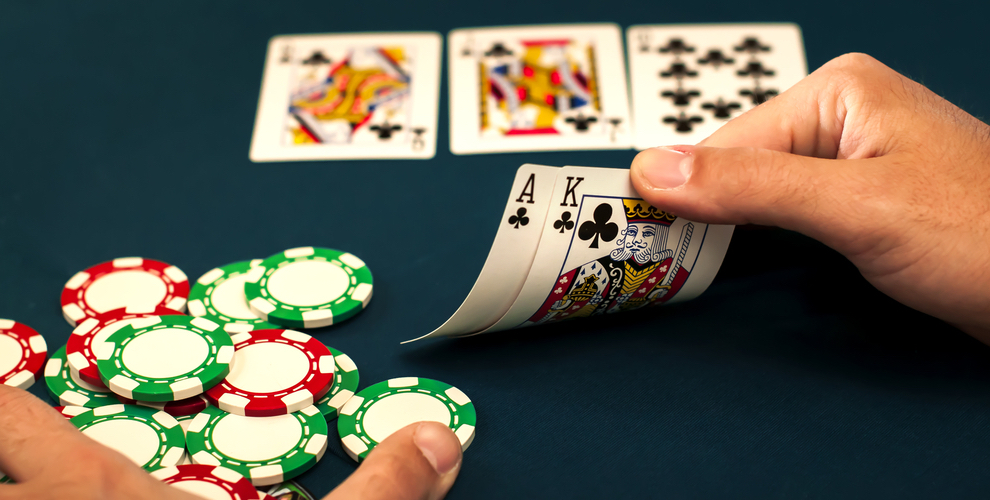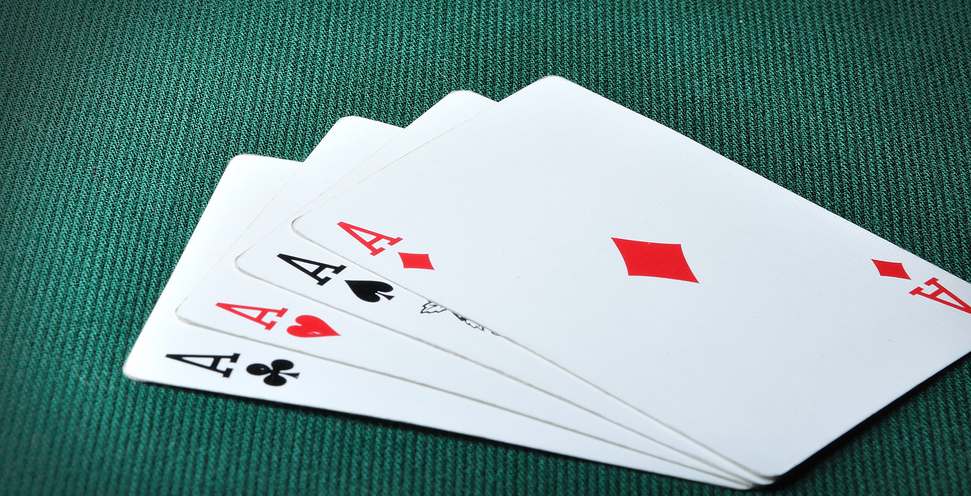Texas Holdem No-Limit: The Definitive Guide

No-Limit Texas Holdem is one the world’s most popular poker games, helped massively with its frequent high-profile tournament plays and easy-to-understand rules.
The game has been snowballing in popularity for many years and although is often said to be unsuitable for beginners, is widely played by newbies wanting to get their feet wet in the poker world.
But instead of the big buy-ins and competitive tournaments, it is advised to focus on the low-stakes No-Limit tournaments if you’re just getting a feel for the game – minimizing the risk on your first runs out.
The game requires a much tighter and more aggressive play than other forms of poker, but it’s not just the play-style that stands as the most daunting aspect of play. In the game of No-Limit Texas Holdem its widely accepted that for the majority of the game, you’re playing the players, not the cards.
As with each and every variation of poker, there are several different ways to play and different playing styles that can be used to ultimately win the money that attracts so many gamers. In theory, it’s possible to win money on every hand, but that same player could win an equal amount by playing as little as 15% of the hands received.
Welcome to the definitive guide to No-Limit Texas Holdem

Texas Holdem defined: how to play
The game begins with a series of hole cards to be dealt clockwise around a table (one at a time) until each player has two in their hand.
Five community cards are then dealt face-up in a total of three stages.
First the flop, in which a series of three cards are dealt into the center, followed by an additional single card known as ‘the turn’ or the ‘fourth street’ and a final card known as ‘the river’ of the ‘fifth street’.
Players work to seek the best five-card poker hand (rankings explained later on) from any combination of the seven total cards (two hole and five community) available. During a round, players can then utilize their betting options of check, call, raise and fold to reach the round end.
The player with the best hand who has no folded by the end of all subsequent betting round wins the entire bet for the hand – known as the pot. Texas Holdem hands ranked from highest to lowest
It may come as a surprise that not all hands are ranked the same in different games of poker.
Texas Holdem hands ranked from highest to lowest
It may come as a surprise that not all hands are ranked the same in different games of poker.
| Hand | Description |
| Royal flush | A straight from the ten card to the ace will five of the cards in the same suit. No suit is more powerful than the next. |
| Straight flush | A straight with all five of the card in the same suit. |
| Four of a kind | Any four cards of the same rank. The higher the rank of the card, the strong the hand is. If two players have the same four of a kind, the bigger fifth card (the ‘kicker’) is used to decide the winner of the pot. |
| Full house | Any three cards of the same rank paired with any two cards of the same rank – regardless of suit. |
| Flush | Any five cards of the same suit – regardless of rank. The highest card of the five is used to determine the rank of the flush making the Ace-high flush the most powerful. |
| Straight | Any five consecutive ranked cards of different suits. Aces can be used to represent high or low cards with the 10, J, Q, K, A as the highest and A, 2, 3, 4, 5 as the lowest. |
| Three of a kind | Any three cards of the same rank. If two players have the same three of a kind, the remaining cards dictate the most valuable hand. |
| Two pair | Any two cards of the same rank paired with another two cards of the same rank. |
| One pair | Any two cards of the same rank. |
| High card | For any hand that is not shown in the above, the highest card will have the highest value. |
Texas holdem hands ranked from highest to lowest
For the main variations of poker, including Texas Holdem, Pot-Limit Omaha, Seven-Card Stud and 5-Card Draw, the hand rankings are all the same (as shown below).
However, for split games including Omaha Hi-Lo and Stud Hi-Lo, half of the pot is awarded to the lowest hand.
For the lowball games such as Razz and 2-7 Triple Draw, only the lowest hand will win the pot and when it comes to straights and flushes, they don’t count in Razz and will work against you in 2-7 – important to know if you’re going into a different game!
Differences between No-Limit Texas Holdem and Limit Texas Holdem

There are two main differences when it comes to the comparison of No-Limit and Limit Texas Holdem involving both position and hand value.
Position is identified as more important in No-Limit as the decisions made will have a great impact on your stack.
For example, if you manage to trap a player in No-Limit but utilising position, you can win your opponents entire stack, eliminating the players, rather than collecting a few extra bets in Limit.
The big connectors such as AK, AQ, and KQ, etc. decrease in value when playing in No-Limit games as players are much more likely to win smaller pots and lose bigger pots with these hands.
Alternatively, all pairs increase in value when playing in a No-Limit game as you can double through opponents when hitting a set. Big pairs such as AA and KK stick to this rule, increasing in value when playing No-Limit with the option to trap another player for their whole stack.
As the variation in stack size greatly affects how No-Limit is played, it’s much more important than Limit to keep track of the amount of money that both you and your opponents have on the table at any one time.
Special moves in No-Limit Texas Holdem
In terms of special moves that you’ll be able to throw into the mix when playing No-Limit Texas Holdem, you’ve got the choice of the following three:
The semi-bluff
The art of semi-bluffing involves betting or raising with a hand that is not yet likely to be the best – but is a hand that may have the potential to out-draw opponents is you’re called or raised.
The semi-bluff is a tactic that you’ll want to use to try and win the pot instantaneously, but that’s not always the case.
By running through the questions on the flop you can make a judgment on who you’re going up against if anyone bets or raises – it might play-out, it might not. Either way, it’s safer than an all-out bluff.
The free card

When finding yourself in a late position or last to act, you will be able to raise with a drawing hand on the flop.
This play is likely to make your opponents check on the turn, allowing you to check if your hand does nothing in terms of improving or bet if you hit your draw.
This tactic will help you save your money if you’re not improving and will reward you with profit if you manage to hit.
The move can backfire if you’re re-raised on the flop and will cost you money. Regardless of this, this remains smart to play with the collection of information alongside a good draw to an even better hand.
The check-raise
In the situation when you’re rocking a good hand and it’s your turn to act, it’s often a good idea to check in the hope that an opponent will respond in a raise.
With this tactic, you’ll be able to raise when the turn comes back around as a response to your opponent(s). This way you’ll find it easier to draw money away from other players, creating a situation where you can potentially build a better hand before it becomes too expensive.
By reviewing the actions of the other players at the table, it’s possible to gauge the hands of the opponent(s). If we’re seeing more money make its way into the pot, you’ll gain an insight into the strength of their hands and be able to decide on the future of your round.
The key strategy for No-Limit Texas Holdem
In terms of strategy for No-Limit Texas Holdem, everyone has their tendencies, tips, and tricks that they like to implement, whether they notice it or not.
However, if you’re looking for the general rules and a general strategy, there are 5 main unwritten rules of the game that you should keep in mind:
It’s important to be very selective with each starting hand that you play. In a standard $2-$4 No-Limit game you should be playing between 20 and 30 percent of all hands dealt. It might seem like very few, but by folding AJ in the first position, KT in the middle position and QT in the late position, you can be sure to be playing smart throughout the game.
Only play in the games where you have an edge. It might be difficult to spot at first, but with experience comes the ability to pick up on weaker players, whether that’s on the casino floor or when playing online.
Always play the players, not just the hands. Quickly assess the players as soon as you sit down and work out the tendencies of the table. Who’s playing inferior hands, who folds with aggression, who bluffs, who can be bluffed etc. etc.
Pump it or dump it. It’s vital that you know when to bet/raise and when to fold when the odds are in your favor or when they’re against you. Generally, you should avoid calling unless you’ve got a reason behind it i.e. bluffing or trapping an opponent.
Respect the big bets. It doesn’t matter who’s doing the betting, it’s always important to respect the big bets, especially on the turn. Most players don’t bet big blindly if there’s a sizeable raise, there’s likely a reason for it.
No-Limit Texas Holdem common mistakes

It’s not just your strategy that needs to stay sharp while you’re at the table, your mind needs to keep strong to avoid the five common mistakes that we often see in No-Limit Texas Holdem:
Keeping a decent hand when you know you’re beat. No matter how good of a hand you’ve got, if you’re beat, you’re beat. If every fiber of your being is telling you to throw away the cards, you should probably do just that. If you like keeping at least some of your stack intact.
Calling when you’ve got nothing but weak holdings when facing a bet. It might feel like a good idea at the time, but what are you actually trying to gain from the situation? Be smart with your play.
Playing way too many starting hands. You should only really be seeing 20-30 percent of your hands received played – any more and you’re in danger of becoming too reckless and playing with subpar cards. Granted, anything can win, but that’s not to say you should play with a J3.
Not raising with high-quality hands preflop and going too far after the flop. This puts plenty of pressure on limpers holding drawing hands and you’ll only be claiming a small chunk of the stack – not the whole thing.
Over/under betting the pot. By missing out on the correct bets for the situation you stand to risk a lot to win very little, not protecting the hand. Keep calm and collected and you’ll be just fine.
Flop play with No-Limit Texas Holdem
Perfecting your flop play is one of the most important pieces to the puzzle when it comes to No-Limit Texas Holdem with the determination of the relative strength of your holding.
Your ability to release good hands when feeling second-best must be developed over time – no matter how strong of a hand you may have. Every hand may stand a chance of winning, but when you’re beat, you’re beat and those odds very quickly trickle back down to 0.
By determining the relative strength of your hand during the game and dumping your hand when you feel you’re not at the top of the podium you can save yourself a lot of hurt through the rounds. Of course, betting is natural is you’re looking to protect what may play out as the winning hand, but you should know on the flop whether you’re going to ‘pump it’ or ‘dump it’.
Pump it or dump it – how to make the right decision
So how do you decide what the correct action is on the flop? There are 5 things you should consider on each hand to give you the best chances of making the right decision:
First thing’s first – what did you flop and what’s the relative strength? Should be easy enough to gauge if you’ve got experience behind you, but you’ll slowly pick up on it if you’re new to the game.
Who, if anyone has, raised before the flop? This is a question that should be asked with your profile of the players in your mind. Are they aggressive, have they done this for the last 4/5 hands, what are we expecting them to do next?
What’s your position relative to theirs? Combine the first two questions and make a judgment on how you fair against the raiser – like your odds or is this one to sit out?
How many others are around the table? It’s much easier to bluff when you’re playing in a smaller group, after all, the more players the more chance that someone’s got a good hand. Are they bluffing and can they be bluffed?
What are your relative stack sizes when compared? A smaller stack size usually means more guarded play, if they’re raising on or before the flop, chances are they’ve got a good hand.
As you have probably guessed by now, you should fold unless you’ve got a good enough reason to doubt your opponent and question their hand. In this case, it’s a good idea to pump-it and play your hand, making your way through the rest of the round. If you’ve got a good-enough hand, your opponents could very well be the underdog in the round.
You should try to save your call unless you’ve got a good reason otherwise. By calling with subpar hands you’ll set yourself up for what we call a ‘guessing game’ in a game where it’s vital to read opponents and make moves. By calling sporadically, you’re setting yourself up for more of an odds based game than a skill-based game – not something you want to encourage when playing poker.
Four typical situations on the flop

Weak hand
Don’t even think about it – throw the cards away and don’t look back.
Medium hand
In the case of a medium hand (top pair with a weak kicker or second pocket pair etc.), it’s often best to avoid betting in this type of hand when in the early position or when playing against numerous players.
The best practice is to try and get a free card to hit one of your pocket cards on the turn, maybe calling or raising an opponent how bets in the last position. However, if you’re in a late position and you’re responding to check it’s best to bet.
If you’re facing a bet, or if you get raised, you should fold unless you’re trying for a strong bluff. The chances are that you’ve got no initiative and are likely chasing false hope.
Strong hand
If you’re opting-in with a strong hand (overpair, top pair with a kicker, etc.) it’s generally a good idea to bet the size of the pot to protect it.
But it’s not always that simple, you may ultimately have to release this hand if it comes to an overbet or raise from an opponent. In these cases, someone could likely hold a better hand that can come out on top after the flop. It’s never recommended to support your top pair with the majority (or all) of your stack.
If you do decide to bet with your strong hand but receive many calls and bets along the way, you’ve got to decide whether or not to continue with play with your hand. It’s likely that your opponents will also be sporting a strong hand.
Very strong hand
If you’ve got a very strong hand (top two pair, set) it’s often a good idea to go for slow-play on an uncoordinated board in an effort to lure opponents in. This will let them create bluffs or let their second-best hands fall short of the mark.
If the board is coordinated and there are several players in, its best to opt-in overbetting the pot. This will lure opponents into making them pay for the attempt of out-drawing you – the bigger the bet, the bigger their mistake.
That’s how you beat your players and make money in poker, by letting other players pay to chase you and taxing them for their stupidity.
A game of chance, a game of skill

Ultimately, No-Limit Texas Holdem is a game of chance blended with a game of skill, so there’s no saying what can happen out on the casino floor or on the virtual tables online.
No matter how you play, what tables your visit and which hands you’re dealt – anything can happen.
It’s vital to keep this in mind in an attempt to minimize your chances of betting on tilt and sabotaging what could otherwise be a game with a successful outcome.
Everyone has different tendencies and trigger points so important to be self-aware and know when you’re starting to play in spite.
Stay calm, collected and focused with the rules and strategies in the back of your mind and you’ll be playing among the best inside no time at all.
After all, it’s just a case of practice makes perfect, just with a small side helping of luck to compliment.






